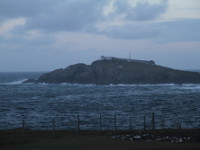
Eagle%20Island%20Lighthouse
West Ireland | County Mayo
Eagle Island Lighthouse is located on a small island approximately 1 km of the northwest part of the Mullet Peninsula, in County Mayo.This island is situated close to the edge of the Continental Shelf where the waves of the Atlantic can be extremely high, and the dramatic story of the lighthouse is strictly linked with them. On the night of 29th September 1835 the first lights of two lighthouses flared on Eagle Island. One lighthouse was built on the east tip of the island, and the other on the west with 120m distance between them. Both were 67 meters above the sea level (east tower about 26m and west tower about 20 m high). Also a massive storm wall was built on the sea side of the towers and seven dwelling houses for Keepers and their families were built until 1841. Already in 1837 the ruthless waves of the Atlantic Ocean have made the first damage, The lantern of the west lighthouse was hit by a rock smashing one of the panes of glass and extinguishing the light (the Keepers had the light working again within an hour). On 5th and 6th February 1850, ocean was even more cruel and disabled the the both lanterns for over one week. Another big breakdown took place on the 11the March of 1861, the waves were so huge that smashed 23 panes from the light room of the east lighthouse and also some of the reflectors were destroyed. The light was restored after more than 24 hours and only with 12 working lamps and reflectors. A huge storm which hit the eastern and northern coast of Ireland in December 1894, of course, did not omit the Eagle Island. The lantern glass was broken what put out the light, also some and damage was done the protecting wall. The dwellings of the East station have been destroyed, what consequently lead to transfer keepers and their families to the mainland. At the end of 1900 they moved in to newly built shore dwellings at Corclough, from where they could semaphore to the island (dwellings were inhabited until 1955, and sold in 1956). In the meantime there was also suggested to improve the west lighthouse and close down the east lantern. On 1st November 1895, the apparatus which had been taken out of Tory Island Lighthouse came to operation (the dioptric first order light with a six wick burner showing group occulting white towards the sea and red towards land) and east lighthouse was disconnected and lopped by 6 meters. Next improvement came in 1927, a new 3rd order triple flashing catoptric lens was launched, and the red light were abolished. On 21st January 1937 the lighthouse was equipped with the radiobeacon (sending out a Morse signal), which worked together with five other radiobeacon stations (two in Ireland, one in Scotland, one in the Scilly Islands, and one in France).The radiobeacon was in service until 1999, then it has been superseded by more modern technology. On 17th July 1968, the lighthouse was converted to electric, and in 2001 the light was changed to a solar powered light with a range of 19 nautical miles (the character was changed to 3 white flashes every 15 seconds). From 1988 Eagle Island Lighthouse is a automatic station in the care of an Attendant.



















